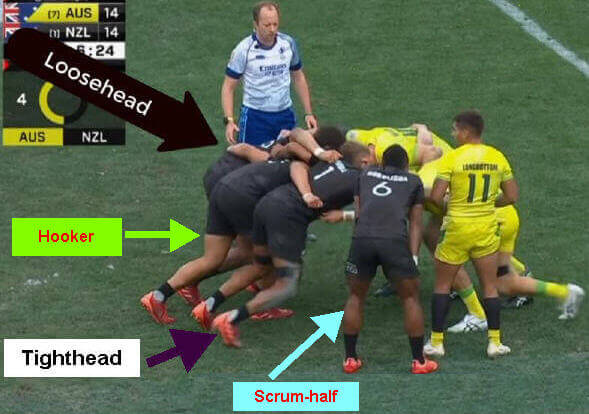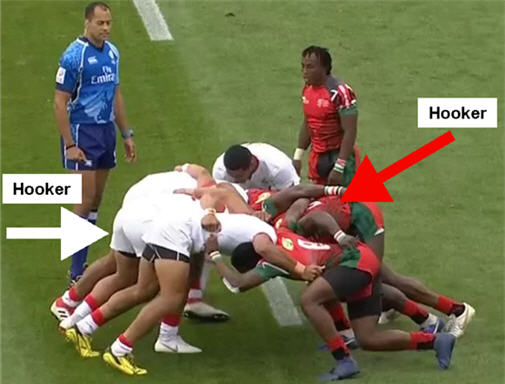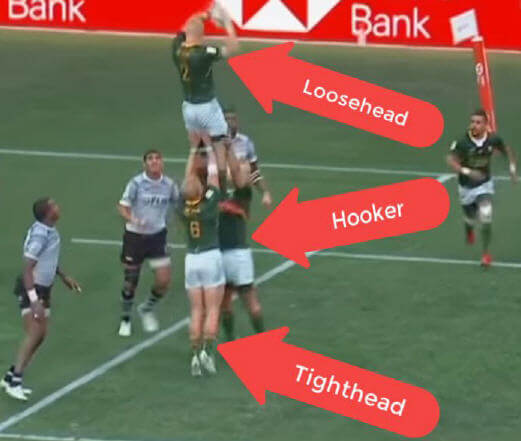There are seven players on the field in a Rugby 7s team. Although all positions call for running and passing skills, some positions have very specific roles in set-piece, attack, and defense.
This article is a round-up of all positions and roles in sevens rugby. You’ll find links to articles that go more in-depth into each position with video clips that showcase the best international players.
Positions In A Sevens Match
Traditionally, we show how the players line up on the field at scrum-time. Here is a simple diagram that approximates what you’ll see on the field.

Here are the positions listed from left to right across the field.
- Loosehead Prop
- Hooker
- Tighthead Prop
- Scrum-half
- Fly-half
- Center
- Wing
Positions in scrums in sevens rugby
Sevens scrums have three forwards pushing against three opposition forwards. You can see this in action in the picture below from an international match between Australia and New Zealand.

Loosehead And Tighthead Prop
The two forwards on the outside of the scrum are known as props or prop forwards. Why? Because they “prop up” the scrum.
More specifically, the forward on the left of the trio is known as the loosehead prop. The opposite side is known as the tighthead prop.
Our article on the role of props in sevens rugby goes into the position in more detail. We look specifically at the skills needed to play prop forward.
Hooker

The forward in the middle of the scrum trio is known as the hooker.
Why? Because his job is to kick or “hook” the ball backward.
Our article on the role of the hooker in sevens rugby has pictures and videos that illustrate the different skills required. We showcase some outrageous skills from international sevens stars.
However, if you just want to see how the hooker strikes the ball out of the scrum, there’s a video that shows a slow-mo of different techniques in action.
If you’re familiar with the fifteen-a-side version of rugby, you’ll know that hookers throw into the line-out in a fifteens match. That has become increasingly rare in the sevens game.
But the hooker is often lifting the jumping player to assist in catching the ball. A lighter hooker can be lifted to make the catch.

Scrumhalf
The scrumhalf has one of the most varied roles in sevens rugby. As their name suggests, they have a specific role at scrum-time. This position feeds the ball into the scrum.
I mentioned in the previous section that hookers in sevens are less likely to throw the ball into the line-out.
This role has been taken by the scrum-half, who often races to get into position to receive the ball from the catcher. Check out our article on scrum-halves in sevens which has a video showcasing this skill.
Leaving set-piece aside, the role of the scrum-half is crucial in open play. Alongside the flyhalf, they act as playmakers in attack.
Scrumhalves are constantly looking to be the link between forwards and backs.
The scrumhalf seeks to support the forwards and pass the ball out to the fly-half or center. They are also expected to look for gaps and break up the field at pace themselves.
Scrumhalves are often the sweeper in defense, who catches opposition breaks through the defensive line. We go into more details on attack and defense in the dedicated article on scrum-halves in sevens.
Flyhalf
This is the position with the most number of different names. You may hear the position called stand-off, outhalf, or second five-eighth.
Fly-halves are regular playmakers throughout a sevens match with excellent passing and running skills.
All positions in a sevens rugby team require good passing and running skills. Traditionally, the fly-half also takes on most of the kicking duties.
That includes kicking the restarts, which is hugely important in sevens. Our article on the role of fly-half in sevens rugby includes a section on restarts.
Center
Centers in sevens rugby act as the link between the flyhalf and the winger in attack. They often give the final pass in wide moves that send the winger running into space.
Although all the backs must have speed, the centers are often larger players who can take the ball into contact.
There are wingers who excelled in the fifteen-a-side game who don’t quite have the top-end speed for international sevens. They may switch to play center in sevens rugby.
Centers also play an important role in defense.
With their position in midfield, they can see the opposition’s attacking play develop across the pitch. They must communicate with their teammates to direct the defensive setup.
Our article on the role of center in sevens rugby goes into detail (with video) on defensive and attacking play.
Winger
In the fifteen-a-side version of rugby, there are matches where the wingers are lucky to get a touch of the ball more than a handful of times across eighty minutes.
But sevens rugby has far fewer defensive players to cover a field of the same size. This means that the one winger on a team is far more involved in attacking play.
The traditional role of the winger is to stay out near the touchline and receive the final pass which sends them running for the try line.
We also thrill at the sight of a winger taking the ball deep in their own half and setting off on a pacy swerving run into opposition territory.
Our article on the role of wingers in sevens rugby has several clips of amazing attacking play by various international stars.
We also look at the top-end speed of wingers at international level. Some of the meters per second these players are reaching would be impressive in Olympic-standard sprints.